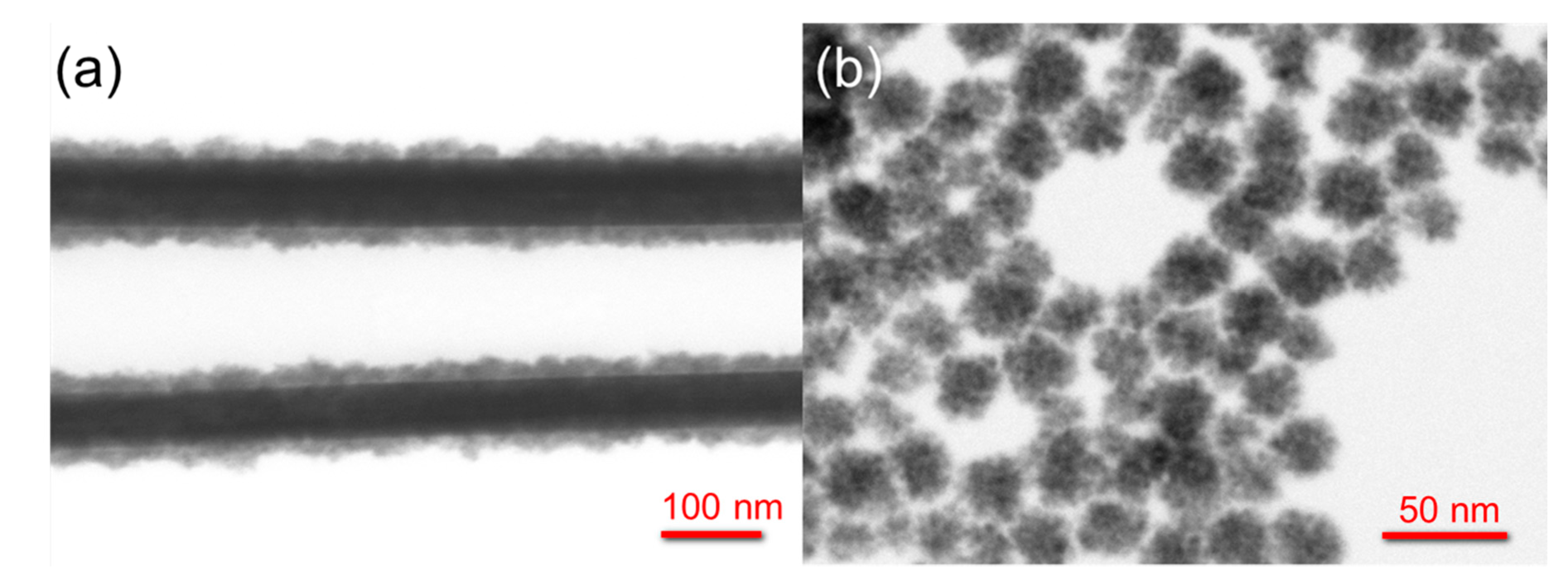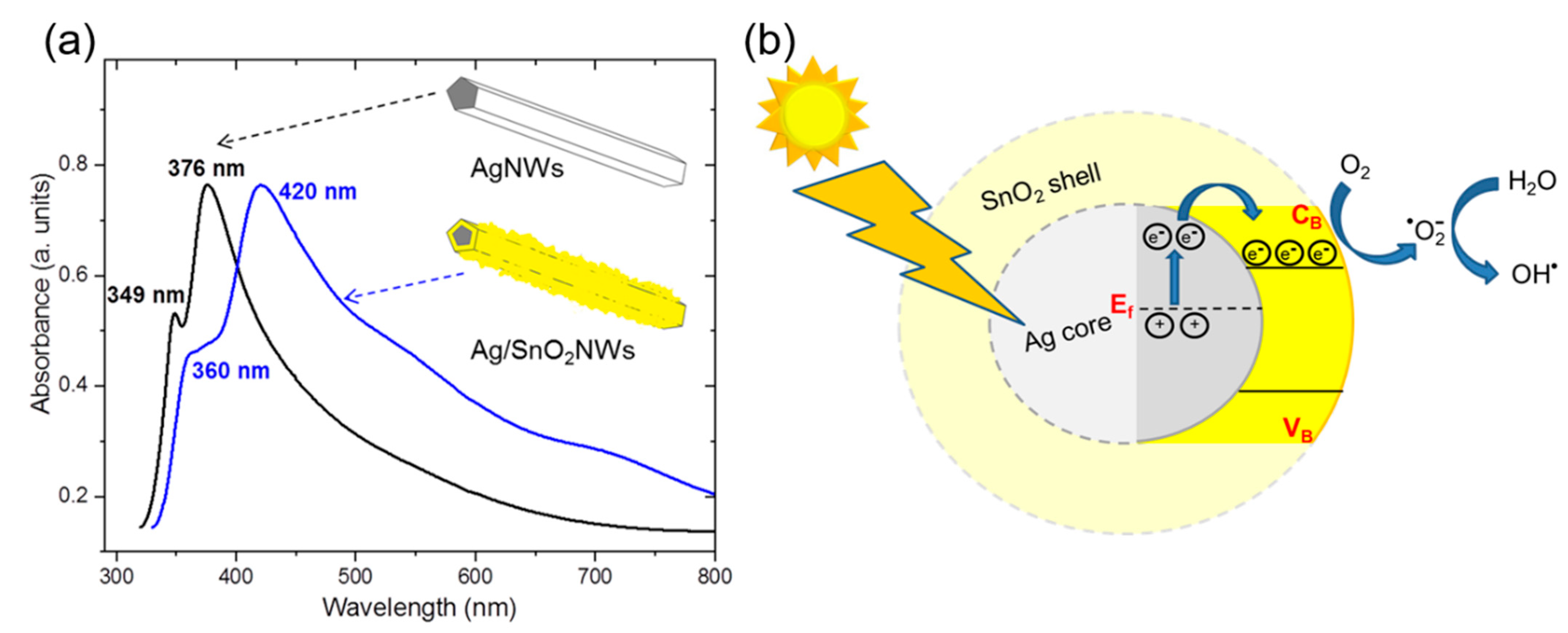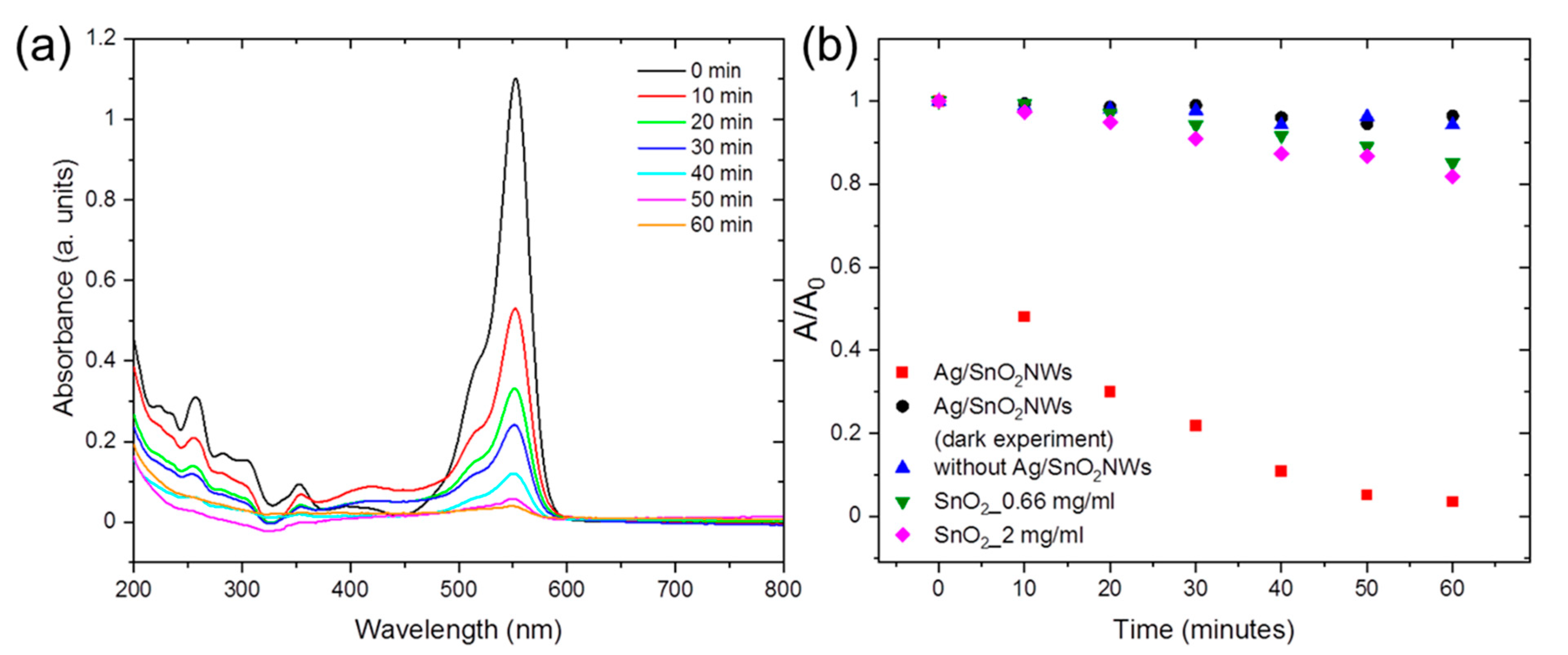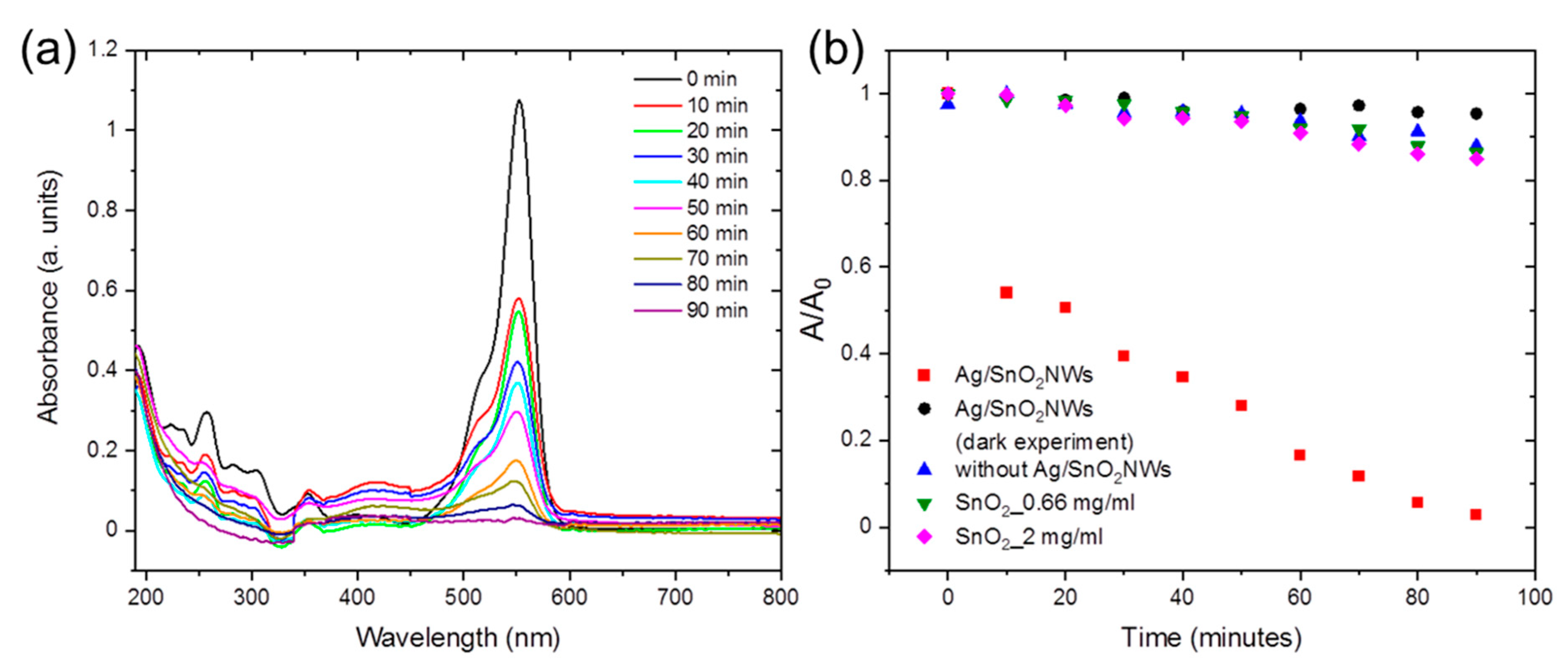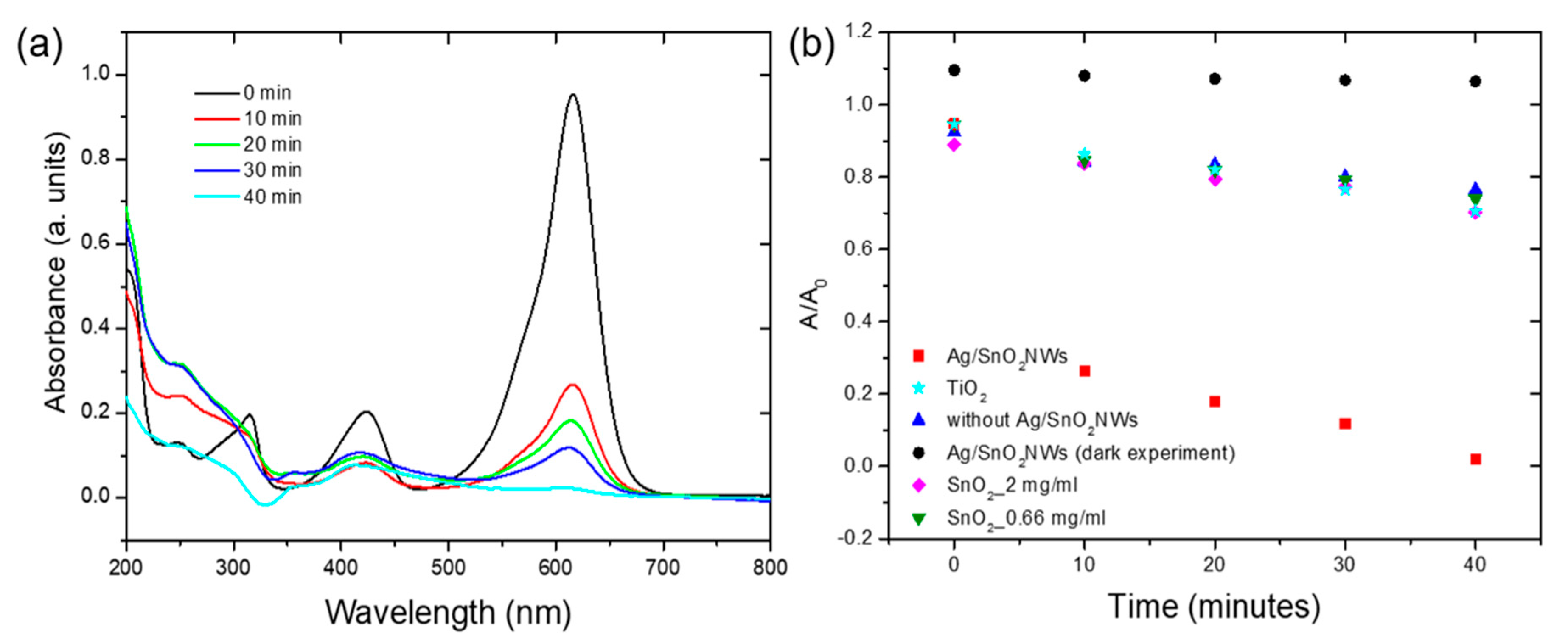1. Introduction
In recent years, due to high environmental pollution and fast industrial development, considerable interest has been paid to designing efficient, rapid, and widely applicable photocatalytic systems that are based on semiconductor nanostructures. The unique physical and chemical properties of semiconductors such as TiO
2, ZnO, ZnS, and CdSe make them extensively studied materials as photocatalysts [
1]. One of the most promising semiconducting metal oxides is SnO
2 because of its high chemical, thermal, and mechanical stability as well as its high performance of organic pollutant degradation. However, a key issue in applying semiconducting nanostructures for practical purposes is the impossibility of visible light utilization. The efficient application of SnO
2 is limited by a large band gap of 3.6–4.1 eV and a very quick recombination of photogenerated electrons and holes [
2,
3]. To overcome these limitations, various metal nanostructures have been applied to form a heterojunction with semiconductors to induce efficient carrier separation under visible light irradiation. Ag-SnO
2 nanocomposite that is synthesized using an electrochemically active biofilm was proposed as a visible light-driven photocatalyst for the degradation of methyl orange, methylene blue, 4-nitrophenol, and 2-chlorophenol [
4]. TiO
2/Ag/SnO
2 ternary heterostructures that were obtained by a one-step reduction approach demonstrated a visible-light photocatalytic effect with high stability and reusability due to the Ag nanoparticle surface plasmon resonance (SPR) influence [
5]. An Ag/SnO
2 composite was also fabricated by the one-pot hydrothermal method and revealed high efficiency towards the photodegradation of phenol under visible light irradiation [
6]. At the same photocatalytic conditions, Ag/Ag
2O/SnO
2 nanoparticles removed malachite green [
7]. Ag-doped SnO
2 nanoparticles that were modified with curcumin were found to be an efficient photocatalyst for the degradation of rhodamine B under visible light [
8]. The composition of Ag and SnO
2 nanoparticles was applied for the photocatalytic removal of nitrogen oxide under solar light [
9]. In addition, Ag-SnO
2 nanocomposites were presented not only as a photocatalytic agent but also their antibacterial and antioxidant properties were investigated [
10].
Ag nanostructures of various dimensionalities were used to form Ag/SnO
2 composites for photocatalytic applications, but Ag nanowires (AgNWs), despite their many advantages, have not been applied previously for these purposes. AgNWs reveal high transmittance, excellent plasmonic properties, high electrical performance, mechanical flexibility, nanometric size, and one dimensional (1D) geometry [
11]. Moreover, the facile separation process of the AgNWs by filtration or sedimentation allows simple processing and improves their applicability in comparison to other silver nanostructures. In the core/shell Ag/SnO
2NWs heterojunction, the advantageous properties of both the nanomaterials can be combined.
This study presents a new photocatalytic system that is based on AgNWs that are coated with an SnO2 shell. The efficiency of the novel core/shell Ag/SnO2NWs photocatalyst was studied based on the absorbance intensity decrease during the decomposition process of rhodamine B, used as a model dye and under light irradiation at the wavelength from the visible range. Rhodamine B decomposes within 50 and 90 min under 395 nm and 450 nm illumination, respectively. Additionally, malachite green decomposes completely within 40 min with the presence of a new Ag/SnO2NWs catalyst whereas typical TiO2 photocatalyst only slightly affects the dye under 450 nm irradiation due to the low absorption in the visible region. The proposed Ag/SnO2NWs system combines 1D morphology and the excellent physico-chemical properties of silver nanowires such as photoabsorption from the visible light region as well as the photocatalytic ability of tin oxide. Moreover, the metal/metal oxide arrangement significantly enhances the semiconductor photocatalytic properties due to fast carrier separation and preventing the recombination of photogenerated electron-hole pairs.
2. Results and Discussion
Ag/SnO
2NWs that were applied to the study were prepared in two processes, the first one was polyol synthesis to obtain AgNWs and then hydrolysis of sodium stannate in the presence of the nanowires to form a SnO
2 shell on the nanowire surface (
Figure 1a). The core/shell Ag/SnO
2 nanowires were composed of 14 nm (±2 nm) thick SnO
2 shell consisting of 7 nm (±2 nm) rutile-type crystals surrounding the metallic core.
Our previous report describes, in detail, both synthesis stages, stability studies, morphological, and structural analysis of the core/shell Ag/SnO
2NWs system [
12]. Despite the fact that AgNWs are characterized by fast atmospheric corrosion, nine weeks are enough to decompose completely; the Ag/SnO
2NWs are stable for over four months at ambient conditions. The core/shell Ag/SnO
2NWs show significant stability in the highly complexing environment of KCN solution. They are resistant to harsh CN
− ions at the concentration range of 0.01 to 0.0001 wt.%. The high stability allows further applying them as a catalyst into various environments for the different pollutant decompositions [
12]. The core/shell arrangement allows the formation of the metal-semiconductor junction to prevent the recombination of the photogenerated electron-hole pairs and to enhance photocatalytic efficiency by photoabsorption from the visible region [
13]. Moreover, the SnO
2 shell acts as a protective coating on silver nanostructures against the influence of different environmental conditions [
12], which provides high stability of the system. The absorbance spectra of AgNWs shows two major bands that are centered around 349 nm and 376 nm, respectively, that are responsible for the longitudinal and transverse modes in the SPR of the nanowires (
Figure 2a). After SnO
2 shell synthesis the above-described peaks were red-shifted to 360 nm and 420 nm for the longitudinal and transverse SPR modes of AgNWs, respectively (
Figure 2a and
Figure S1). It was shown previously that the SPR of silver nanowires is sensitive to the applied different coating as a result of the surrounding media dielectric constant changes [
14]. In this study, the redshift allowed tuning of the absorbance properties and shifting the maxima of main absorbance bands to the visible light region. The absorbance spectra, typical for SnO
2, showed a peak at about 193 nm [
15]. To study, in detail, the optical properties of the system, the hydrolysis process of sodium stannate in the aqueous solution without the silver nanowires presence was carried out. In this reaction, the pure SnO
2 nanoparticles (SnO
2NPs) were prepared that were similar in morphology and structure to the SnO
2 shell (
Figure 1b). The nanoparticles revealed a mean diameter of about 25 nm (STEM analysis) and their properties were described in our previous report [
16]. The absorbance spectra of SnO
2NPs shows the band with the maximum at 195 nm (
Figure S2) that was suitable for photocatalysis induced by UV light. The value of the band gap for semiconducting nanostructures that was obtained by our method was calculated based on the Tauc plot (
Figure S2) to be about 4.17 eV. This value is in good agreement with the reports for tin oxide nanoparticles [
2].
The core/shell Ag/SnO
2NWs were used for the degradation of rhodamine B as a model organic dye that is characterized by an absorbance band with a maximum of 553 nm. Rhodamine B is widely applied for the photocatalytic model reaction study because it is broadly representative of organic compounds in its class and, since it strongly absorbs light, this allows facile monitoring of its degradation by UV/Vis spectroscopy [
17]. The intensity of the band was studied under the irradiation of precisely defined sources, 395 nm and 450 nm LED lamps, corresponding electromagnetic radiation from the wavelength range of visible light. This approach can optimize the future photodegradation system for removing pollutants using solar irradiation instead of applying sophisticated and expensive UV-light sources (
Figure S2). After coating AgNWs with an SnO
2 shell, the nanowires revealed effective photoabsorption at the visible light region due to the absorption band at 420 nm and partially by longitudinal mode at 360 nm (
Figure 2a). The core/shell Ag/SnO
2NWs were dispersed homogeneously in an aqueous solution of rhodamine B. The shell formation prevented the nanowires from the aggregation process because SnO
2 is an efficient inorganic stabilizer of silver colloidal suspensions [
16]. This phenomenon allows AgNWs introduction to the hydrophilic environment without aggregation and acting as a part of efficient photocatalyst as well as can also facilitate the redispersion process of Ag/SnO
2NWs after sedimentation.
Figure S3a shows the separation process by sedimentation of the nanowires after 48 h. The nanowires were collected as sediment on the bottom of the vessel. This simple separation process of nanomaterials from the solution can be applied as a method of removing solvent with the decomposed pollutants after the photocatalysis process. A gentle mixing of the solution after sedimentation resulted in obtaining a homogenous mixture due to the SnO
2 coating on AgNWs, preventing the aggregation process (
Figure S3b).
The intensity absorbance of rhodamine B was measured every 10 min after illumination by the selected light source. The samples were centrifuged for photocatalyst separation and further study of the optical properties of the supernatant with the dye.
Figure 3a shows absorbance spectra of the supernatant with rhodamine B at the selected time points after 395 nm LED light irradiation. The absorbance intensity significantly decreased after 10 min of illumination and the dye was completely degraded in less than 1 h. It indicates the high efficiency of Ag/SnO
2NWs as a photocatalyst under the irradiation from the visible light region. To study the process in detail and the influence of different factors on the photodegradation process, rhodamine B degradation was studied under various conditions (
Figure 3b). It is essential to study all the conditions and system components to avoid the possibility of spectral interferences by transformation intermediates which may absorb radiation at the wavelength of the dye’s absorption maximum [
18]. The ability of the degraded substance to inject electrons into the conduction band of a semiconductor should be primarily tested. Rhodamine B with the Ag/SnO
2NWs photocatalyst presence but not light-irradiated (dark experiment) did not show any degradation process (
Figure S4). The dye sample without the Ag/SnO
2NWs but illuminated by 395 nm LED lamp revealed a slight decrease in the absorbance intensity (
Figure S5) and proved that the photodegradation effect appears only in the presence of Ag/SnO
2NWs. Moreover, the contribution of SnO
2 in the photodegradation process in this range of illumination was verified. For these purposes, SnO
2 was synthesized using stannate precursor as in the case of the shell but without AgNWs presence. The process resulted in SnO
2 nanoparticles (SnO
2NPs) formation, described in our previous report [
16]. To compare the influence of SnO
2 on the photocatalytic activity the Ag/SnO
2NWs, SnO
2NPs were added to the dye solution at the concentration of the whole core/shell complex (2 mg/mL) and at the concentration of the tin oxide in the shell (0.66 mg/mL) (
Figure 3b). The weight percentage of the SnO
2 shell in Ag/SnO
2NWs complex was determined on the EDS studies and was about 33 wt.% (
Figure S6). SnO
2 is known as an efficient photocatalyst under UV irradiation [
19,
20,
21]. In our system, after irradiation by light from the visible region, both concentrations of SnO
2NPs showed a slight degradation rate of rhodamine B as a result of the negligible influence of this radiation on tin oxide nanostructures (
Figure 3b and
Figure S7).
The rapid photodegradation of the dye under 395 nm illumination for about 60 min using Ag/SnO
2NWS is due to the formation of a metal/semiconductor heterostructure which prevents the fast recombination of photogenerated electron-hole pairs. The irradiation at the wavelength of 395 nm can excite only SPR of AgNWs in the core/shell composite and cause electron transfer from AgNWs to the conduction band (CB) of SnO
2 (
Figure 2b). The carrier migration is a result of combining two materials with different work functions; Ag is characterized by a work function of 4.26 eV and SnO
2 with a work function of about 4.84 eV [
22,
23]. The photoinduced electrons can get sufficient energy to surmount the Schottky barrier on the Ag/SnO
2 interface despite the uniform energy levels of both components. The electrons are transferred to the semiconductor material to equilibrate the metal-metal oxide alignment and form a new Fermi energy level (
Figure 2b). The transferred free electrons are trapped by dissolved oxygen molecules in the water and form a high oxidative species, such as superoxide radical anions (O
2−•) and hydroxyl radicals (HO
•) [
4]. In the core/shell heterostructure arrangement, the recombination of the photoinduced hole-electron pairs is inhibited mainly by forming a complex of free electrons from the CB with oxygen molecules. The trapped electrons can facilitate the formation of O
2-• and HO
• reactive radicals and significantly enhance the rate of their formation, increase photocatalytic activity, and reduce organic substance degradation time. The absorbance intensity of rhodamine B decreased by half after 10 min of irradiation. Moreover, the strong confinement and anisotropic effect in the 1D core/shell metal/semiconductor structures can facilitate carrier separation and increase photocatalytic efficiency.
To the best of our knowledge, it is the first report presenting the photocatalytic properties of the 1D core/shell Ag/SnO
2NWs nano-system. It can broaden the range of AgNWs applications since SnO
2 revealed a high environmental stability [
12]. The silver nanostructures tend to aggregate and dissolve in the aquatic environment, so the protective shells are also applied to increase stability, processability, and range of applications. The ability of the new catalyst to decompose organic compounds under solar irradiation combined with a high resistance even to harsh conditions can allow the designing of photodegradation systems for various environments and without any external irradiation sources. The advantage of the presented Ag/SnO
2NWs photocatalyst is its high stability under different conditions in comparison to other silver/wide band semiconductor composites. An example of that hybrid is Ag/ZnO heterostructure, which, although revealed high photocatalytic activity [
24], both its components show a low stability. Silver nanostructures are affected by atmospheric corrosion due to the effective interaction of Ag+ ions with sulphides and the formation of a silver sulphide layer [
25]. ZnO is easily degraded at the nanoscale in hydrophilic environments [
26]. Another, more stable semiconductor of TiO
2 that was combined with various Ag nanostructures revealed photocatalytic activity that was characterized by a degradation time of 60 min [
27] and more than 90 min [
28], but under UV-light. Ag nanowires that were modified with an α-Fe
2O
3 show similar efficiency and time of the process; methylene blue was degraded for 30 min under visible light illumination, according to the authors, due to the synergetic effect of LSPR and the effective separation of photogenerated carriers between both materials [
29]. A ternary TiO
2/Ag/SnO
2 system was applied for the photodegradation of methylene blue for more than 140 min for 40 mg of the photocatalyst of 3.12 × 10
−5 methylene blue (100 mL) under visible light irradiation [
5]. Ag/Ag
2O/SnO
2 nanocomposites removed malachite green (20 mg/L) after 120 min by using 30 mg of the photocatalyst [
7]. The photocatalysis process under visible light with the addition of Ag-SnO
2 nanocomposites that were synthesized using electrochemically active biofilm was measured in hours, but was significantly efficient than for pure SnO
2 [
4]. The sphere-like plasmonic Ag/SnO
2 photocatalyst revealed a phenol decomposition time of 50 min that was similar to our results but with different dimensionalities allowing the application of them to other purposes [
6].
To study the photodegradation process with Ag/SnO
2NWs catalyst that was induced by the light from the visible region, an additional light source from this area at the wavelength of 450 nm was chosen. The removal efficiency of rhodamine B was similar for 395 nm and 450 nm light sources and was calculated to be about 87% and 88% for irradiation at 395 nm and 450 nm (
Figure S8). However, the degradation time was not comparable; the process took about 50 and 90 min for irradiation at 395 nm and 450 nm, respectively. The efficiency of the degradation was also high, but the time that was needed to decompose the dye increased to about 90 min (
Figure 4a). Both the SPR bands that were irradiated at 450 nm were not so effectively excited as for the 395 nm source. The AgNWs absorbed only the irradiation above 450 nm and their absorbance spectrum was only partially excited (
Figure 2a). The process was still efficient and significantly higher than for pure SnO
2 irradiated under 450 nm (
Figure 4b).
Similar to the 395 nm excitation source (
Figure 3b), the absorbance intensity of the dye under illumination at the wavelength of 450 nm without the photocatalyst did not change significantly, indicating the minimal influence of the irradiation on the optical properties of rhodamine B (
Figure 4b and
Figure S9). The experiment with Ag/SnO
2NWs photocatalyst, without applying irradiation (dark experiment,
Figure S4), showed only a minimal decrease in the absorbance intensity and demonstrated the stability of the dye and the essential influence of light illumination in the decomposition process. The irradiation at the wavelength of 450 nm on SnO
2NPs at both concentrations, 2 mg/mL as Ag/SnO
2NWs and 0.66 mg/mL corresponding to SnO
2 amount in the core/shell complex, showed a slight degradation rate of rhodamine B (
Figure S10). It indicated that the selected irradiation source did not significantly affect the organic substances when using pure semiconductor as a photocatalyst, only the Ag/SnO
2 heterojunction can be considered as a source for the utilization of organic pollutants under visible light.
Ag/SnO
2NWs were also applied for the degradation of malachite green, which is present in the environment and its remediation is highly required. Malachite green is a dye that is commonly used in the textile and food industry. It should be removed after industrial processes due to the fact that it is highly toxic, especially for aquatic flora and fauna [
30,
31,
32].
Figure 5a shows the rapid degradation of malachite green by Ag/SnO
2NWs under the light from the visible range (450 nm); malachite green was completely decomposed after 40 min. The absorbance intensity of the dye with Ag/SnO
2NWs photocatalyst presence but without any irradiation did not change significantly (
Figure 5b and
Figure S11). The dark experiment proved the photodegradation mechanism for fast malachite green decomposition. Malachite green irradiation at the wavelength of 450 nm without photocatalyst revealed only a slight decrease in the absorbance intensity (
Figure 5b and
Figure S12). The irradiation of SnO
2NPs at both concentrations, 2 mg/mL as Ag/SnO
2NWs and 0.66 mg/mL corresponding to SnO
2 amount in the core/shell complex also showed only a slight degradation rate of malachite green (
Figure 5b and
Figure S13). Moreover, to compare Ag/SnO
2NWs photocatalyst efficiency at the visible range to a well-known commercial photocatalyst, malachite green was treated with TiO
2 under 450 nm irradiation. TiO
2 as a semiconductor that is characterized by absorption in the UV range, decomposed the dye only to a minimal extent (
Figure 5b,
Figures S14 and S15) [
33]. The core/shell Ag/SnO
2NWs system shows a high degradation rate of organic pollutants under visible light irradiation and can be used in practical photocatalysis reactions for efficient remediation.
